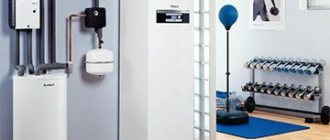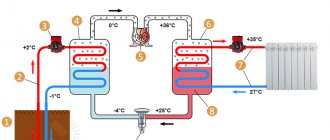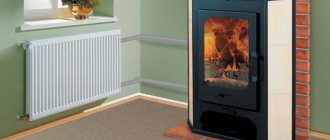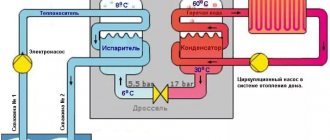In winter, a country house must be heated even in the absence of the owners. The problem of heating a cottage far from the gas distribution network often becomes an insurmountable obstacle to life on earth. Heating with electricity is too expensive even for a wealthy person, and hiring an outsider to stoke a wood or coal stove is risky. The most progressive solution to this problem is heating using a geothermal heat pump (GHP).
What is a geothermal heat pump
Planetary energy can be used on any part of the earth. Geothermal springs with boiling water bubble up only where hot magma comes close to the surface. In the rest of the space, heat from the center of the Earth is distributed evenly. Therefore, at a depth below the soil freezing level, the same temperature is maintained year-round.
The purpose of the HHP is to pump heat from the soil or reservoir into the house. Energy is collected from the surrounding area by pipes, and then a compressor heats the water for the heating system of the cottage. Therefore, from 1 kW of electricity spent, 3-5 kW of heat is obtained.
Device
For the gas turbine to operate, three independent systems are required: intra-house, compressor, and external circuits. They are combined into one circuit by heat exchangers in which various coolants circulate.
The gas turbine unit consists of the following components:
- Home heating system, for which it is better to use heated floors.
- Hot water supply.
- The condenser transfers the energy collected from outside to the indoor heating fluid.
- The evaporator takes thermal energy from the coolant circulating in the external collector.
- The compressor pumps refrigerant from the evaporator, converting it from a gaseous to a liquid state, increasing the pressure and cooling it in the condenser.
- An expansion valve is installed before the evaporator to regulate the flow of refrigerant.
- The external collector pipes are laid on the bottom of the reservoir or lowered into wells.
- Pumps.
- Automation for controlling the turbocharger according to a given room heating program, which depends on changes in the outside air temperature.
The external circuit coolant is pumped by a pump and heated underground or in a reservoir. Inside the evaporator, energy is transferred to the refrigerant, which enters the compressor where the pressure and temperature increase.
The condenser transfers heat to the cottage heating system. The refrigerant then passes through the choke, where the pressure drops sharply due to the increase in volume. When it transforms into a gaseous state, the temperature of the refrigerant decreases greatly. A significant temperature difference accelerates the absorption of heat by the refrigerant from the external collector.
Operating principle
The excess heat transfer scheme has been used in everyday life for 70 years. For example, ice forms inside a freezer due to heat extraction from the refrigerant. From the outside, this energy is discharged into the indoor air by the radiator grille. Touch it with your hand - it is always hot when the refrigerator is running.
The same operating principle is used for the operation of the gas turbine engine, but the processes are a little more complicated:
- When the refrigerant enters the evaporator, this phase is called isothermal expansion. Freon receives heat from the external collector, the pressure drops.
- Then adiabatic compression occurs - the compressor increases the pressure of the refrigerant. At the same time, its temperature rises to +70 °C.
- Passing the condenser, freon becomes a liquid, as it transfers heat to the heating circuit at increased pressure. This phase is called isothermal compression.
- When the freon passes through the choke, the pressure and temperature drop sharply. Adiabatic expansion occurs.
Operating such a complex mechanism is almost as easy as operating a refrigerator. When the installation work is completed, and all systems are connected, tested, adjusted, the user will only switch a few toggle switches and buttons. For example, to set different heating temperatures for a children's room, living room, kitchen.
Advantages
The main advantage of the gas turbine engine is that you do not need to burn coal, gas, or wood to heat your home. A heat pump collects energy from the surface of the earth or from deep wells, concentrates it, and then sends it to the heating system of the cottage.
Over time, the geothermal heat pump is becoming more and more in demand, as it has a number of advantages:
- Environmentally friendly.
- Uses a renewable energy source.
- After commissioning is completed, there are no regular costs of consumables.
- Automatically adjusts the heating inside the house based on the outside temperature.
- The payback period for initial costs is 5-8 years.
- You can connect a boiler for hot water supply to the cottage.
- In summer it works like an air conditioner, cooling the supply air.
- Long service life - more than 30 years.
- Minimum energy consumption - generates from 4 to 6 kW of heat with 1 kW of electricity consumed.
- Complete independence of heating and air conditioning for a cottage “remote from civilization” in the presence of an electric generator of any type.
- Adaptation to the smart home system for remote control and additional energy savings is possible.
The rise in energy prices has almost no effect on the budget of gas turbine owners. If you install a wind or solar generator, you will have absolute energy independence.
Flaws
Installation and commissioning of gas turbine pump systems is a technologically complex set of works that can only be performed by experienced specialists. Not everyone can do the same with their own hands, so it’s easier to buy a geothermal heat pump with installation and subsequent maintenance. The total cost of equipment and component materials is significantly higher compared to conventional gas heating equipment. Therefore, the payback period for initial costs extends over many years.
There are other disadvantages:
- Due to the constant extraction of geothermal energy near the location of the external collector pipes, the soil cools. In the north, the short summer does not provide the opportunity to fully restore the energy potential of the environment. Because of this, the efficiency of the turbocharger gradually decreases over about 5 years. Then thermal equilibrium stabilizes.
- Drilling wells is an expensive undertaking, especially in dense soil or rock.
- There is an option with an open external collector, when you can get by with two wells: one for collecting groundwater, and the second for draining back into the aquifer. This option is only possible if the water quality is good, because filters quickly become clogged if there are too many hardness salts or suspended microparticles. Before installation, it is necessary to do an analysis of the water from the well.
- The heating is filled with water heated to +35 °C. At this temperature, conventional radiators will not effectively heat the building, so it is necessary to use a “warm floor” system.
- The electric motor, compressor, and pump create vibration and noise during operation.
Unpleasant effects can be easily avoided if the equipment is placed in a utility room or basement. Be sure to install forced ventilation. Freon leakage is dangerous to human health.
Types of pumps
Over time, the benefit of a geothermal heat pump for heating a home, despite high prices, is becoming increasingly obvious due to the constant increase in fuel costs. A properly selected and high-quality installed gas turbine unit provides heat regardless of the time of year and market fluctuations in energy costs.
There are several options for installing an external collector, which allows you to adapt the heat pump to the specific conditions of the land adjacent to the house:
- The pipes are laid in trenches to a depth below the soil freezing level. In the south of Russia, the ground freezes to a maximum of 0.5 m, so it is easier to completely remove the layer of earth at the installation site with a grader, lay the collector, and then fill the pit with an excavator.
- If there is a body of water near the house at a distance of no more than 100 m, then the most economical and effective option is used - the pipes are laid under water to a depth of 3 meters or more.
- Dry sandy soils will not provide sufficient heat flow, so drilling wells up to 50 meters deep is used to reach the aquifer. Pipes are lowered into the wells.
- If the water from the well is of good quality, then it is enough to drill only two: one to draw groundwater, and the second to drain back into the aquifer.
Drill a drain well at a distance of 20 meters from the intake well and downstream of the aquifer.
Water-to-water type
A relatively inexpensive type of water-to-water turbocharger is recommended for use when there is a lake, pond, river or sea nearby. The efficiency of such a system is achieved due to the maximum amount of convective heat exchange between the external environment and the coolant that circulates in the collector pipes. Savings are achieved due to ease of installation. The coils are spread on the surface of the water, then weights are attached to the pipes and the system is flooded to a depth of 3 meters or more.
If there is no reservoir nearby, then you can use the option with an open collector. In this case, the energy potential of good quality groundwater is used. Then the system and the pump are not threatened by siltation, deposition of hardness salts, or accelerated corrosion. Water is taken from one well, pumped through the gas turbine heat exchanger, and then poured into another, which should be located at a distance of 15-20 meters.
If a drilled well quickly silts up or the water contains a lot of hardness salts, then stable operation of the gas turbine pump is ensured by drilling more wells. The loops of the sealed outer contour are lowered into them. Then, cement from a clay-sand mixture is poured into the wells.
Soil-water type
When there is no reservoir near the house and it is not possible to drill wells, then the pipes are laid horizontally below the freezing depth of the soil. If the groundwater lies close to the surface, then the efficiency of the ground-water system is almost the same as that of a water-water turbocharger, since the operating principle is the same. In the south of Russia, the amount of soil freezing is less than 0.75 m, so they dig a pit 1 meter deep, lay out the external circuit pipes, and then fill them up. In northern regions, the soil freezes deeper, so it is more economical to dig parallel trenches.
Selection criteria and calculations
When choosing gas turbine equipment for preliminary calculations, a simplified formula is usually used: 700 watts of heat are required per 10 m² of heated building. Then a 17.5 kW heat pump is suitable for a house with an area of 250 m². To provide the cottage with hot water, multiply the final figure by 15%.
When calculating the payback period of a gas turbine unit, take into account the operating costs for the entire service life of the equipment - at least 30 years. Assuming that current fuel prices remain unchanged, then geothermal heat pumps are the most economical heating method for country cottages.
In just 1 year the savings will be compared to:
- gas boiler - 70%;
- electric heating - 350%;
- solid fuel boiler - 50%.
If you multiply the benefits received by 30 years, the savings will be many times greater than the initial costs.
conclusions
Geothermal equipment is one of the best ways to create autonomous heating if the ability to connect to centralized communications is not possible due to various reasons. When choosing the optimal system option, many factors are taken into account, including the location of the heated object and the budget of its owner. You can make a heat pump yourself. There are many options for assembly based on an old refrigerator or split system. Useful information can be gleaned from the video below.
Review of popular brands and their prices
To provide a private home with geothermal energy, it will be necessary to solve a large number of technological problems. This is done efficiently and on time only by experienced specialists from Russian companies who have been working in the market for a long time.
Popular heat pump manufacturers can be divided into three price categories:
- Cheap Chinese ones. For example, Meeting (China) with a maximum power of 7 kW for a heated area of 50-100 m² at a price of 95,200 rubles.
- Under the American brand Mammoth, equipment is produced in China: maximum power 7.8 kW, heated area 50 m², price 261,000 rubles.
- The most expensive products are produced by German companies. For example, Stiebel Eltron: maximum power 9.9 kW, heated area 50 m², price RUB 645,000.
To avoid unforeseen situations in the future, it is better to choose a company that provides a full range of services: performs design work, supplies equipment, performs installation, commissioning and maintenance.
Prices for the range of geothermal heat pumps
geothermal heat pump
Geothermal System Installation
The construction of the gas turbine complex consists of three independent sections of work: the internal heating system, the heat pump and the external circuit.
Installation of the external circuit consists of the following steps:
- Complete design work.
- Carry out test drilling to analyze the soil.
- Drill wells with vertical placement of collector loops or dig a pit for horizontal pipe laying.
- Place external circuit pipes in the pit or wells.
- Fill the pipes with coolant and bleed air from the system.
- Connect all loops of the circuit to the collector.
- Perform a pressure test of the entire system to identify and eliminate possible leaks.
- Connect the manifold to the turbocharger equipment.
- Do a test run.
- Connect the heating system of the house and regulate the operation of the entire complex.
To place the equipment, select a separate utility room with a temperature not lower than +14 °C. Prepare the home heating system for commissioning.
What costs does installation require?
The compressor, pumps, automatic gas turbine units require uninterrupted power supply. In case of a power outage, purchase an electric generator with automatic start.
Installation of a gas turbine unit includes costs for:
- a set of basic equipment with a compressor, heat exchangers, automation;
- drilling wells and digging pits;
- collector installation;
- coolant for external pipes - propylene glycol;
- boiler for hot water supply;
- installation;
- commissioning works.
Total installation costs, taking into account the cost of wells, range from 5 to 10 thousand dollars. When using an open reservoir it will be 30-50% cheaper.
Briefly about the main thing
Geothermal heating is a promising but underappreciated system for private homes. It can be organized in three ways: in a vertical well, in the form of a horizontal underground collector, or under water.
Heating with underground heat is economically beneficial; The maximum effect from the installation can be achieved by using heated floors. The system operates year-round: in winter it heats rooms, and in summer it reduces the air temperature, which eliminates the need for air conditioning. Many country house owners are in no hurry to choose environmentally friendly technology due to the high costs of purchasing and installing equipment.
Recommendations for care and maintenance
After completion of commissioning work, the owner controls only two buttons: on/off and winter/summer mode (heating or air conditioning), and also regulates the temperature in different rooms.
Annual inspection and maintenance are carried out by service specialists: monitoring the absence of leaks of freon, lubricant, coolant, and the operation of automation.
The gas turbine achieves maximum efficiency if you decide on the choice of heating system at the early stages of building design. Then it is possible to choose the optimal materials and thickness of enclosing structures with the required thermal conductivity and thermal inertia.
The greatest heat loss usually occurs through windows. Therefore, triple glazing is not a luxury at all, but an economically sound construction solution. The ideal option is to use glass that can reflect infrared rays.
Why us
Reliable 10 year warranty on all products
Favorable conditions 0% installment plan
432 objects were completed by our specialists
Delivery on time Prompt delivery and unloading of goods
- We have completed more than 250 installations of heat pumps over the past 3 years in Moscow and the Moscow region.
- Our specialists have been trained at equipment manufacturers' factories. Employees have the necessary certificates and permits to carry out work.
- Own drilling rigs of different types and sizes. By using our own rather than rental equipment, we reduced the cost of preparatory work.
- Full 10-year warranty on heat pumps installed and connected by us.
- Own service department. A prompt visit by a specialist allows you to quickly solve any problems that arise with your heating or air conditioning system.
- Legal registration of each transaction. An official contract listing all stages of work. Payment upon completion of work.
- Providing interest-free installments for all equipment.











